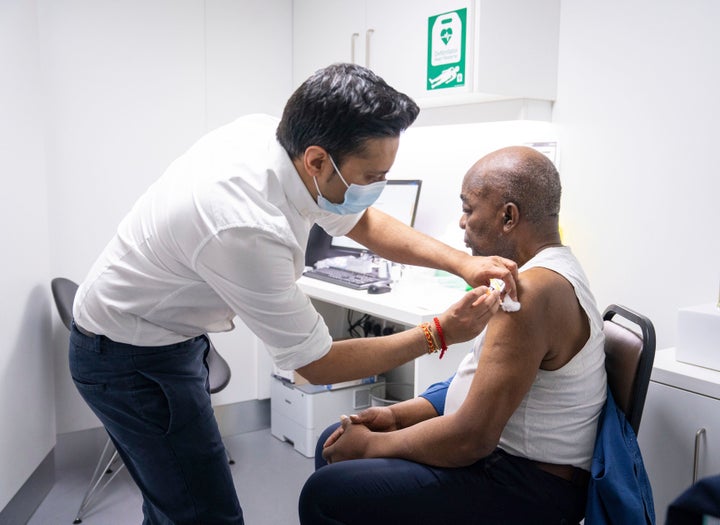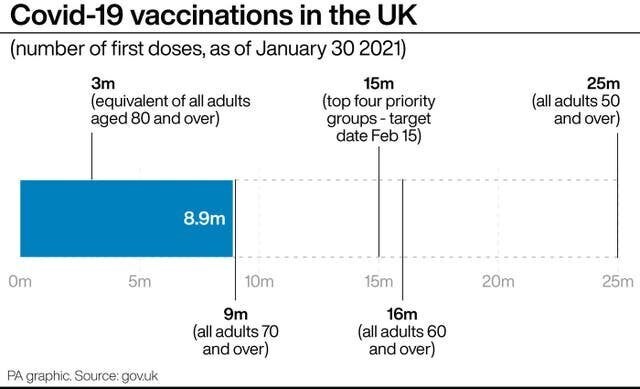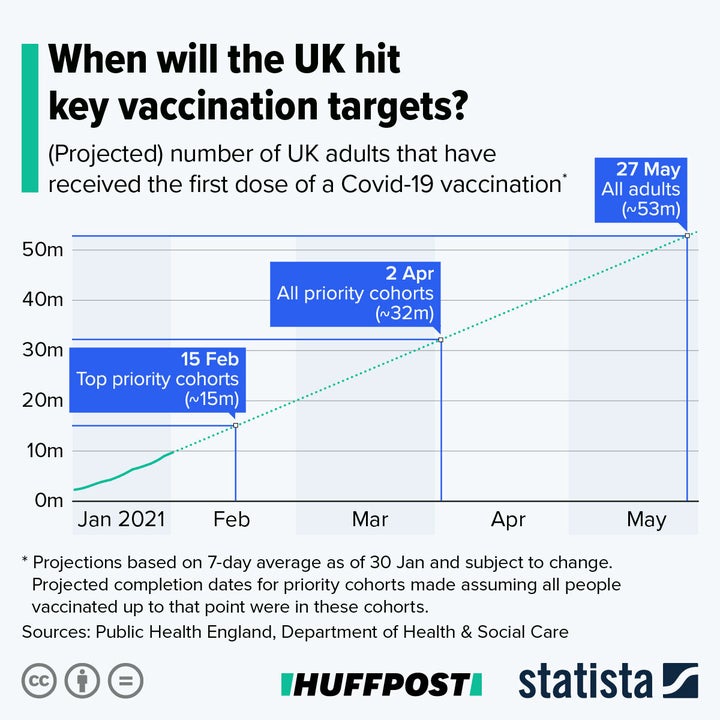
Saturday was a remarkable day in the UK’s Covid-19 vaccination programme, as nearly 600,000 people received a jab in just 24 hours.
The total number of people to have received a dose to 9,790,576.
The figures are encouraging, and, while it is still early days, offer some hope that the government’s aims of offering a vaccine to the first four priority groups by February 15, and to all adults “by the autumn”, could be achieved.
Prime minister Boris Johnson praised the “phenomenal” achievement on Monday, but would not be drawn on whether the government would meet its targets.
“I think it would be unwise to speculate at the moment. I think the NHS, the pharmacies, the volunteers, helped by the Army, they have done an outstanding job,” he said. “The rollout has been phenomenal so far but it is still, relatively speaking, early days.”
This is where things stand with the vaccine rollout:
What are the targets?

The most vulnerable
The only target with a definitive date so far is vaccinating the 15 million most vulnerable people by February 15.
Based on the latest figures, an average of 401,512 first doses of vaccine would be needed every day for the target to be met.
On the current trajectory and if the high number of daily vaccinations seen over the weekend continue, the UK would reach that target a day early on February 14.
All adults
The other target publicly discussed by minister’s is that of offering all UK adults a jab by September. This amounts to around 53m people including those in all the vulnerable groups.
On the current trajectory, this could be achieved by May 27, but there are a number of stumbling blocks that could slow this down significantly.

For instance, this obviously assumes the current trajectory continues, but there has been a massive variation in the number of jabs given each day.
For example, on January 23, 491,970 people received their first jabs, but this dropped to 220,249 the day after.
When asked what accounts for this variation, an NHS spokesperson told HuffPost UK: “Sites have the Covid vaccine delivered to them as it becomes available to the NHS, with more and different types of vaccination site coming online each week since the programme began.
“So while there are fluctuations in the reported number of daily jabs, the trajectory is clear with delivery and numbers vaccinated both increasing as more supplies come on stream.”
The supply
Enough doses need to be approved and then acquired in large enough numbers to offer everyone two doses of each.
So far, the government has ordered:
- 100 million AstraZeneca/University of Oxford doses (approved by UK regulator)
- 40 million BioNTech/Pfizer doses (approved)
- 17 million Moderna doses (approved)
- 60 million Novavax doses (not yet approved)
- 60 million Valneva doses (not yet approved)
- 60 million GSK/Sanofi Pasteur doses (not yet approved)
- 30 million Janssen doses (not yet approved)
The UK’s supply of coronavirus jabs over the next two years now totals 407 million doses, ministers have said.
The total was given a boost after the government ordered millions more doses of the Valneva Covid-19 vaccine candidate.
With three vaccines now approved, the biggest stumbling block is manufacturing enough doses.
“It is a challenge but is probably realistic in terms of manufacturing enough vaccine to do that,” Dr Stephen Morris, research fellow in vaccine process analytics at University College London, told HuffPost UK last month.
“It’s an advantage that they’re all using different technologies so they’re not competing for the same reagents and other supplies of materials.
“There will also be a challenge as more countries authorise the vaccines as deliveries will be spread across more countries.”
The UK does have an ace up its sleeve – the Vaccine Manufacturing and Innovation Centre that is currently being built in Harwell.
If all goes to plan it will be able to vaccinate the entire country in four months but it’s not scheduled to open until autumn which will be too late to help the government in meeting its targets.
“This has been on the cards for a while and was originally planned to open next year,” says Dr Morris.
“It was designed as a platform for the likes of myself to test out new manufacturing technologies so it’s designed to be very flexible but now it’s been repurposed to some degree.
“That in theory will have enough manufacturing capacity to produce enough vaccine for the UK.”
The bigger picture
The UK isn’t the only country buying up vaccines and scrambling to secure enough for its citizens. This was thrown into sharp focus last week when a political scrap between Britain and the EU broke out.
Boris Johnson has said he is “very confident” in the security of the UK’s supply of coronavirus vaccines regardless of “the toings and froings” in the European Union.
The PM said on Sunday we “will continue to take steps to protect” the deliveries, in his first public comments since Brussels briefly overrode part of the Brexit deal on Northern Ireland to impose export controls on jabs.
His comments came after ministers agreed to a “reset” in relations with the EU after the bloc’s widely-criticised move that came as it battles to solve supply shortages from pharmaceutical giant AstraZeneca.
